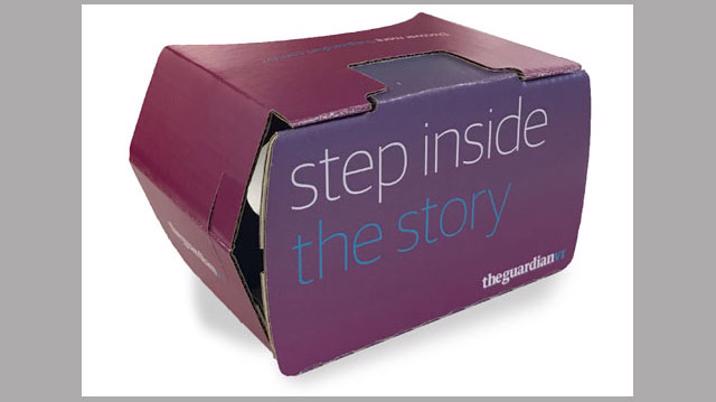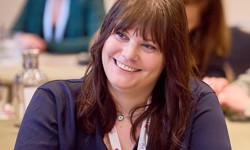
According to Francesca Panetta, executive editor, virtual reality at The Guardian, VR technology is still very much in its infancy. Only when we have developed voice-activated, wearable technology that layers visuals in front of our eyes, rather than fiddling around with tiny smartphone screens, will VR really come into its own.
In the meantime, The Guardian is staying true to its reputation for innovation by making sure that it is investing in virtual reality at this early stage in its development. Since Panetta started heading up The Guardian’s new VR team in 2016, it has produced a series of standalone, high impact virtual reality projects.
The first film to come out of the new team was 6x9: a virtual experience of solitary confinement, which gives the viewer a taste of what life is like for the more than 80,000 prisoners in the US who are confined to their cells for between 22 and 24 hours a day.
Other VR projects include First Impressions, which uses the latest research into how babies’ brains develop and how they see colour to grant viewers access to what the world looks like through newborn eyes. Meanwhile, Arctic 360 makes the point that this endangered region of the world does not need any more visitors, and instead allows us to appreciate its frozen beauty from the comfort of our own homes.
All you need to do is download the Guardian’s VR app to your smartphone and then insert it into a headset, either Google’s Daydream View or the cheaper Google Cardboard. For the last year, The Guardian has had a partnership with Google, “which has enabled us to support what we are doing”, reveals Panetta, adding: “You can make 360 film really cheaply, but the techniques we’ve been using and the complicated storytelling we’ve been doing is expensive.”
In October 2017, The Guardian demonstrated its commitment to VR by giving away 97,000 Google Cardboard headsets to readers. Panetta explains: “We wanted to give our readers the opportunity to see the pieces. The response has been great; I wasn’t really sure what the response would be. We didn’t know whether people would be able to assemble them, whether people would get cross. We had some schools asking whether we could send more sets. We had a good conversion rate – higher than we had anticipated.”
Google launched its Daydream View headset using its Daydream virtual reality platform in November 2016, following on from the launch of the Google Cardboard headset earlier that year. Other tech giants have also brought out or are working on VR headsets, including Samsung’s Gear and Facebook’s Oculus Rift, while Apple is strongly rumoured to be working on if not a virtual reality headset then an augmented reality one.
Journalistic potential
The question for Panetta is how this evolving technology can be tethered to enhance The Guardian’s journalism. She reveals: “I think it’s a really interesting new form of journalism for The Guardian. There’s the potential to give you different perspectives.” She adds: “There are some incredibly strong things you can do. It has a visceral nature that some other mediums don’t have. It’s easy to make someone feel very small or very frightened. That sense of being there in that world is very strong.”
In its first year, the VR team has focused largely on first person stories, such as The Party, which sees a gathering of family and friends through the eyes of a 15-year-old girl with autism. Then there is Limbo, which lets the viewer feel what it is like to be an asylum seeker, thousands of miles away from home and living on just £5 a day while waiting for a decision on whether they will be allowed to stay.
“I guess we are looking at things that feel like Guardian topics. Everything that is in our list I could imagine us covering [in a different way],” explains Panetta. “All of those things feel like home territory: research for autism, or the interview process for asylum seekers.” But she adds: “You can’t translate every single piece of journalism. My job is to think whether we would do this in VR. It really needs to make sense for you to be in that story. We are quite ruthless about choosing ideas. If there is a lot of statistical information or where it’s more intellectual, it might not make sense.”
Ideas come both from within the team and from other Guardian desks. “There’s not a strict commissioning process because there are so few pieces that we like to be open,” says Panetta. “I’ve been at The Guardian for eleven years, so I’ve got good relationships throughout the organisation and Nicole [deputy editor, virtual reality and a former features editor on The Guardian’s Weekend magazine] was a journalist before she moved into the VR team. I’ve worked in innovation for six or seven years, so people are used to me fiddling around with tech. A lot of the way newsrooms work is relationships and people trusting you when they come to you with ideas.”
Crime Scene, which puts the viewer into the shoes of a trainee forensics officer dealing with a suspected murder, sprung from an idea from a journalist elsewhere in the organisation, who assisted the VR team by setting up visits to forensics labs. To portray the world through a newborn’s eyes for First Impressions, Panetta and her colleagues worked closely with The Guardian’s science reporters.
Cross-fertilisation
Cross-fertilisation of ideas is important to the team. “We have our own space full of kit, but we go to morning conference, we’re involved in the multi-media teams. When we’ve got an idea, we’ll bring on a journalist; when we are prototyping, when we get scripts, we’ll sense check them with other people,” says Panetta.
There is a range of talents within the team. Panetta herself started out as a sound engineer and then a radio producer for the BBC, before joining The Guardian to work on its early podcasts, before branching out into other multimedia technologies. “We’re a team with really different backgrounds: our technologist’s job is to decode technology for us, whereas the filmmakers will be able to bring in different filmic possibilities. Because it’s quite a small team, it’s all about continuous learning across the team rather than saying ‘I do the journalism, you do the tech’,” she explains.
When a project calls for it, the team will also work with external partners. For example, 6x9, which features a virtual solitary confinement cell built in CGI, was made in collaboration with content creation studio The Mill. Limbo was created alongside ScanLAB Projects, a creative practice that specialises in digital replicas of environments for broadcast. The piece uses innovative 3D scanning techniques to capture a monochrome vision of urban streets and interiors. But Panetta points out: “We are always quite clear up front that we will creatively direct the piece, we’re not just commissioning someone else to do something, we are always quite involved in the storyline.”
For another project, Sea Prayer, which commemorated the second anniversary of the tragic death of Alan Kurdi, the three-year-old Syrian refugee boy who drowned while trying to reach Greece with his family in 2015, written by Khaled Hosseini, The Guardian turned to VR artist Liz Edwards. The piece, narrated by the BAFTA award winning actor Adeel Akhtar, who plays the boy’s father, reflecting back on their life in the now war-torn city of Homs, uses Tilt Brush, a tool for painting in 3D space with virtual reality. Panetta says the fact that Edwards is based in Montreal, Canada, actually helped the process: “The time difference was really wonderful, we’d give her notes and she’d sketch for the next day.”
What next for VR
Panetta’s focus now is learning from what they have done so far and applying that to planning for the future. “What we are trying to do is summarise what this year’s learnings are and think about what things to try next year.” She is very excited by the possibility of creating new experiences for viewers. “Experiential – there’s huge potential for that. A lot of the stuff you see doesn’t make enormous use of that. It’s very early days, it’s still quite hard technology to make stuff, so we’re all making small prototypes.”
She believes there is still a long way to go with using VR as a journalistic tool, and compares the medium to the early days of podcasting. “It’s still very early. I think the technology is taking a while to develop. It needs to be easy to use and it’s not really easy to use yet. There’s still a huge barrier, downloading the pieces, downloading the app, putting the phones in and out of the headset.
“I came to The Guardian in 2006, I started with podcasting which didn’t instantly take off. Now it has because we’ve got these phones where you can instantly stream them. We need to get to the stage where you have wearables, or maybe contact lenses, then your media will be another element of that world. While we’re still strapping headsets on our head, it’s still very early tech. I think in the end, it will be driven by the technology changing. At some stage, it will be voice activated with visuals layered on. At that stage, our media will look really different.” When will that be? “Maybe in ten years.”
For now, it is about helping to “define form”, says Panetta. “Defining form before the standards are set is really interesting and it’s important to be seen at the forefront of leading innovation. The Guardian has been really brave for decades, launching our multimedia platforms before anyone else. People come to us because they see us as progressive and not stuck in the old 19th century newspaper world.”
All pictures courtesy of The Guardian.












